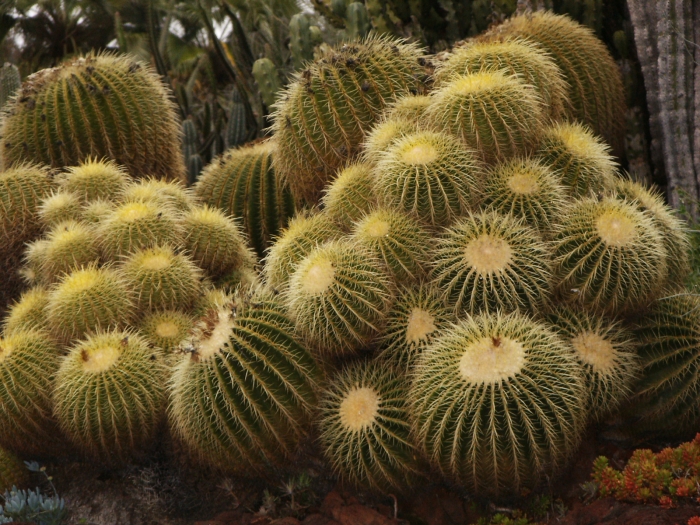Golden Barrel Cactus
(Echinocactus grusonii)
Golden Barrel Cactus (Echinocactus grusonii)
/
/

Pamla J. Eisenberg from Anaheim, USA
CC BY-SA 2.0
Image By:
Pamla J. Eisenberg from Anaheim, USA
Recorded By:
Copyright:
CC BY-SA 2.0
Copyright Notice:
Photo by: Pamla J. Eisenberg from Anaheim, USA | License Type: CC BY-SA 2.0 | License URL: https://creativecommons.org/licenses/by-sa/2.0 | Uploader: File Upload Bot (Magnus Manske) | Publisher: Wikimedia Commons | Title: Golden_Barrel_cactus,_Huntington_Desert_Garden.jpg | Notes: {{Mihael Simonic|info= {{en|Butterflies on a flower from the ''Allium'' family in Alpine Botanical Garden, Trenta, Slovenia}} {{sl|Metulji na čebulnici(?) v Alpskem botaničnem vrtu Julijana v Tr


























Estimated Native Range
Summary
Echinocactus grusonii, commonly known as Golden Barrel Cactus, is an evergreen succulent native to arid and semi-arid regions in central and eastern Mexico. It is characterized by its large, spherical globe shape that can eventually exceed 1 meter (3.3 ft) in height after many years, although it grows slowly. The plant’s appearance changes significantly as it matures; young plants may have a knobbly texture and lack the pronounced ribs seen in mature specimens, which can have up to 35 ribs. The spines are long, straight or slightly curved, and typically yellow, but can occasionally be white. The Golden Barrel Cactus produces small yellow flowers around the crown after about twenty years, mainly in the summer months. These flowers are not particularly showy, but they add interest to the mature plant.
The Golden Barrel Cactus is highly valued for its sculptural form and is often used as an ornamental plant in containers, desert gardens, rockeries, and conservatories. It is also popular in modern garden designs as an architectural accent. This cactus is easy to maintain and relatively fast-growing in warm climates. It requires minimal winter temperatures of 12 °C (53.6 °F) and good drainage, with reduced watering in winter to prevent rot. It is frost hardy to about −8 °C (15 °F) for short periods. In cultivation, it thrives in full sun and is adaptable to very low, low, or medium water conditions, preferring soils with fast drainage. Cultivars with white spines and short spines are also available. Potential problems include root rot due to overwatering, especially in cooler weather.CC BY-SA 4.0
The Golden Barrel Cactus is highly valued for its sculptural form and is often used as an ornamental plant in containers, desert gardens, rockeries, and conservatories. It is also popular in modern garden designs as an architectural accent. This cactus is easy to maintain and relatively fast-growing in warm climates. It requires minimal winter temperatures of 12 °C (53.6 °F) and good drainage, with reduced watering in winter to prevent rot. It is frost hardy to about −8 °C (15 °F) for short periods. In cultivation, it thrives in full sun and is adaptable to very low, low, or medium water conditions, preferring soils with fast drainage. Cultivars with white spines and short spines are also available. Potential problems include root rot due to overwatering, especially in cooler weather.CC BY-SA 4.0
Plant Description
- Plant Type: Succulent
- Height: 2-3 feet
- Width: 2-3 feet
- Growth Rate: Slow
- Flower Color: Yellow
- Flowering Season: Summer
- Leaf Retention: Evergreen
Growth Requirements
- Sun: Full Sun
- Water: Very Low
- Drainage: Fast
Common Uses
Bee Garden, Drought Tolerant, Fire Resistant, Low Maintenance, Potted Plant, Rock Garden
Natural Habitat
Native to arid and semi-arid regions in central and eastern Mexico
Other Names
Common Names: Gold Barrell Cactus, Golden Ball Cactus, Mother-In-Law’s Cushion, Goldkugelkaktus, Schwiegermuttersessel, Svärmors Kudde
Scientific Names: , Echinocactus grusonii, Echinocereus grusonii, Kroenleinia grusonii, Echinocactus grusonii var. albispinus, Echinocactus corynacanthus, Echinocactus galeottii, Echinocactus grusonii var. horridus, Echinocactus grusonii var. intertextus, Echinocactus grusonii var. subinermis
GBIF Accepted Name: Echinocactus grusonii Hildm.